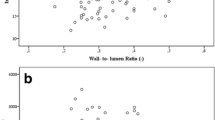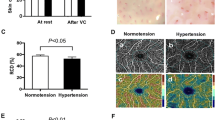Abstract
Arterial hypertension represents a leading cause of cardiovascular mortality and morbidity worldwide through its detrimental effects on target organs. Therefore, the early identification and appropriate management of high-risk patients emerges as extremely important. Given that the microvasculature is subject to a series of morphological and functional changes under the continuous effect of high blood pressure, research over the last years has gradually moved toward the identification of specific microcirculatory alterations that may serve as early prognostic markers of cardiovascular risk. Dermal capillaries represent an “open window” for the in vivo study of human microcirculation that has been long used mainly for the study of rheumatic diseases. However, capillaroscopy has been relatively understudied and only recently applied in the field of hypertension. Capillaroscopy represents a forthcoming promising estimate of the microvascular status in hypertensive patients, with capillary rarefaction representing the most typical finding. The present review aims at summarizing available evidence and the main findings, as well as the premises and promises, of capillary rarefaction as a tool for evaluating patients with hypertension.


Similar content being viewed by others
References
Papers of particular interest, published recently, have been highlighted as: • Of importance •• Of major importance
Kearney PM, Whelton M, Reynolds K, Muntner P, Whelton PK, He J. Global burden of hypertension: analysis of worldwide data. Lancet. 2005;365:217–23.
Vlachopoulos C, Aznaouridis K, Stefanadis C. Prediction of cardiovascular events and all-cause mortality with arterial stiffness: a systematic review and meta-analysis. J Am Coll Cardiol. 2010;55:1318–27.
Triantafyllou A, Anyfanti P, Zabulis X, Gavriilaki E, Karamaounas P, Gkaliagkousi E, et al. Accumulation of microvascular target organ damage in newly diagnosed hypertensive patients. J Am Soc Hypertens. 2014;8:542–9. This paper revealed that capillary rarefaction in the skin was the most common form of microvascular organ damage (hypertensive retinopathy, microalbuminuria, and capillary rarefaction) in a population of never-treated patients with recent onset hypertension compared with healthy volunteers. This paper also showed that accumulation of multiple microvascular organ damage was associated with an aggravated cardiovascular risk profile, even at the very time of the establishment of hypertension diagnosis.
Garg JP, Bakris GL. Microalbuminuria: marker of vascular dysfunction, risk factor for cardiovascular disease. Vasc Med. 2002;7:35–43.
Ding J, Wai KL, McGeechan K, Ikram MK, Kawasaki R, Xie J, et al. Retinal vascular caliber and the development of hypertension: a meta-analysis of individual participant data. J Hypertens. 2014;32:207–15.
Antonios TF, Nama V, Wang D, Manyonda IT. Microvascular remodelling in preeclampsia: quantifying capillary rarefaction accurately and independently predicts preeclampsia. Am J Hypertens. 2013;26:1162–9.
Wang TJ, Evans JC, Meigs JB, Rifai N, Fox CS, D’Agostino RB, et al. Low-grade albuminuria and the risks of hypertension and blood pressure progression. Circulation. 2005;111:1370–6.
Thom S, Stettler C, Stanton A, Witt N, Tapp R, Chaturvedi N, et al. Differential effects of antihypertensive treatment on the retinal microcirculation: an anglo-Scandinavian cardiac outcomes trial substudy. Hypertension. 2009;54:405–8.
Agrawal B, Wolf K, Berger A, Luft FC. Effect of antihypertensive treatment on qualitative estimates of microalbuminuria. J Hum Hypertens. 1996;10:551–5.
Cummins H. Kennedy RW. Purkinje’s observations (1823) on finger prints and other skin features. J Crim Law Criminol. 1940;31:343–56
Lombard WP. The blood pressure in the arterioles, capillaries, and small veins of the human skin. Am J Physiol. 1912;29:335–62.
Baran R, de Berker DAR, Holzberg M, Baran LT, Dawbers. Imaging the nail unit. In: John Wiley and Sons editor. Diseases of the Nails and their Management(Google eBook) 126;2014.
Shore AC. Capillaroscopy and the measurement of capillary pressure. Br J Clin Pharmacol. 2000;5:501–3.
Karamaounas P, Zabulis X. Capillaroscope. Institute of Computer Science-FORTH: Heraklion Greece; 2008. Technical Report 417, [cited 2011 May]. Available from: https://doi.org/users.ics.forth.gr/~zabulis/2011.TR417_Capillaroscope.pdf
Antonios TF, Singer DR, Markandu ND, Mortimer PS, MacGregor GA. Structural skin capillary rarefaction in essential hypertension. Hypertension. 1999;33:998–1001.
Williams SA, Boolell M, MacGregor GA, Smaje LH, Wasserman SM, Tooke JE. Capillary hypertension and abnormal pressure dynamics in patients with essential hypertension. Clin Sci (Lond). 1990;79:5–8.
Chen II, Prewitt RL, Dowell RF. Microvascular rarefaction in spontaneously hypertensive rat cremaster muscle. Am J Physiol. 1981;241:306–10.
Sokolova IA, Manukhina EB, Blinkov SM, Koshelev VB, Pinelis VG, Rodionov IM. Rarefication of the arterioles and capillary network in the brain of rats with different forms of hypertension. Microvasc Res. 1985;30:1–9.
Ruedemann AD. Conjunctival vessels. JAMA. 1933;101:1477–81.
Lack A, Adolph W. Biomicroscopy of conjunctival vessels in hypertension; a capillary hypertension pattern and the occurrence of intravascular clumping (sludged blood) are described. Am Heart J. 1949;38:654–64.
Prasad A, Dunnill GS, Mortimer PS, MacGregor GA. Capillary rarefaction in the forearm skin in essential hypertension. J Hypertens. 1995;13:265–8.
Serne EH, Gans RO, ter Maaten JC, Tangelder GJ, Donker AJ, Stehouwer CD. Impaired skin capillary recruitment in essential hypertension is caused by both functional and structural capillary rarefaction. Hypertension. 2001;38:238–42.
Debbabi H, Uzan L, Mourad JJ, Safar M, Levy BI, Tibirica E. Increased skin capillary density in treated essential hypertensive patients. Am J Hypertens. 2006;19:477–83.
Antonios TF, Kaski JC, Hasan KM, Brown SJ, Singer DR. Rarefaction of skin capillaries in patients with anginal chest pain and normal coronary arteriograms. Eur Heart J. 2001;22:1144–8.
Hasan KM, Manyonda IT, Ng FS, Singer DR, Antonios TF. Skin capillary density changes in normal pregnancy and pre-eclampsia. J Hypertens. 2002;20:2439–43.
Noon JP, Walker BR, Webb DJ, Shore AC, Holton DW, Edwards HV, et al. Impaired microvascular dilatation and capillary rarefaction in young adults with a predisposition to high blood pressure. J Clin Invest. 1997;99:1873–9.
Antonios TF, Singer DR, Markandu ND, Mortimer PS, MacGregor GA. Rarefaction of skin capillaries in borderline essential hypertension suggests an early structural abnormality. Hypertension. 1999;34:655–8.
Antonios TF, Rattray FM, Singer DR, Markandu ND, Mortimer PS, MacGregor GA. Rarefaction of skin capillaries in normotensive offspring of individuals with essential hypertension. Heart. 2003;89:175–8.
Hudetz AG. Percolation phenomenon: the effect of capillary network rarefaction. Microvasc Res. 1993;45:1–10.
D’Souza R, Raghuraman RP, Nathan P, Manyonda IT, Antonios TF. Low birth weight infants do not have capillary rarefaction at birth: implications for early life influence on microcirculation. Hypertension. 2011;58:847–51.
Antonios TF, Raghuraman RP, D’Souza R, Nathan P, Wang D, Manyonda IT. Capillary remodeling in infants born to hypertensive pregnancy: pilot study. Am J Hypertens. 2012;25:848–53. According to this study, infants born at term to mothers with hypertensive disorders of pregnancy exhibit more pronounced capillary rarefaction at birth compared to term infants born to normotensive mothers, in favor of the hypothesis that capillary rarefaction in essential hypertension is likely to be a primary vascular abnormality. Interestingly, this study also showed that preterm infants with low birth weight born to hypertensive mothers tended to have higher skin capillary densities compared with term infants, possibly as an intrauterine compensatory microvascular response to the placental insufficiency that led to low birth weight.
Boegehold MA, Johnson MD, Overbeck HW. Pressure-independent arteriolar rarefaction in hypertension. Am J Physiol. 1991;261(1 Pt 2):H83–7.
Prewitt RL, Chen II, Dowell R. Development of microvascular rarefaction in the spontaneously hypertensive rat. Am J Physiol. 1982;243:H243–51.
Kubis N, Besnard S, Silvestre JS, Feletou M, Huang PL, Levy BI, et al. Decreased arteriolar density in endothelial nitric oxide synthase knockout mice is due to hypertension, not to the constitutive defect in endothelial nitric oxide synthase enzyme. J Hypertens. 2002;20:273–80.
Serne EH, Gans RO, ter Maaten JC, ter Wee PM, Donker AJ, Stehouwer CD. Capillary recruitment is impaired in essential hypertension and relates to insulin’s metabolic and vascular actions. Cardiovasc Res. 2001;49:161–8.
Irving RJ, Walker BR, Noon JP, Watt GC, Webb DJ, Shore AC. Microvascular correlates of blood pressure, plasma glucose, and insulin resistance in health. Cardiovasc Res. 2002;53:271–6.
Feihl F, Liaudet L, Waeber B, Levy BI. Hypertension: a disease of the microcirculation? Hypertension. 2006;48:1012–7.
Lin SZ, Sposito N, Pettersen S, Rybacki L, McKenna E, Pettigrew K, et al. Cerebral capillary bed structure of normotensive and chronically hypertensive rats. Microvasc Res. 1990;40:341–57.
Cheng C, Diamond JJ, Falkner B. Functional capillary rarefaction in mild blood pressure elevation. Clin Transl Sci. 2008;1:75–9.
Prewitt RL, Hashimoto H, Stacy DL. Structural and functional rarefaction of microvessels in hypertension. In: BocaRaton FC, editor. Blood Vessels Changes in Hypertension. 1990:71–90
James MA, Tullett J, Hemsley AG, Shore AC. Effects of aging and hypertension on the microcirculation. Hypertension. 2006;47:968–74.
He FJ, Marciniak M, Markandu ND, Antonios TF, MacGregor GA. Effect of modest salt reduction on skin capillary rarefaction in white, black, and Asian individuals with mild hypertension. Hypertension. 2010;56:253–9.
Penna GL, Garbero RF, Neves MF, Oigman W, Bottino DA, Bouskela E. Treatment of essential hypertension does not normalize capillary rarefaction. Clinics (Sao Paulo). 2008;63:613–8.
Serne EH, Stehouwer CD, ter Maaten JC, ter Wee PM, Rauwerda JA, Donker AJ, et al. Microvascular function relates to insulin sensitivity and blood pressure in normal subjects. Circulation. 1999;99:896–902.
Debbabi H, Bonnin P, Levy BI. Effects of blood pressure control with perindopril/indapamide on the microcirculation in hypertensive patients. Am J Hypertens. 2010;23:1136–43. This study suggests that both capillary rarefaction and endothelial dysfunction in hypertensive patients are reversible with proper antihypertensive treatment. However, according to this study, not all drugs are equal with regard to these effects, suggesting a beneficial role of the combination perindopril/indapamide compared to other agents, regardless of blood pressure control.
Kaiser SE, Sanjuliani AF, Estato V, Gomes MB, Tibirica E. Antihypertensive treatment improves microvascular rarefaction and reactivity in low-risk hypertensive individuals. Microcirculation. 2013;20:703–16. This is the first prospective study addressing the effects of antihypertensive therapy on capillary rarefaction, showing that capillary rarefaction and microvascular endothelial dysfunction in hypertensive patients responded favorably to long-term pharmacological treatment with metoprolol or olmesartan.
Martina B, Weinbacher M, Drewe J, Gasser P. Effects of losartan titrated to losartan/hydrochlorothiazide and amlodipine on blood pressure and peripheral capillary microcirculation in patients with mild-to-moderate hypertension. J Hum Hypertens. 1998;12:473–8.
IJzerman RG, de Jongh RT, Beijk MA, van Weissenbruch MM, Delemarre-van de Waal HA, Serne EH, et al. Individuals at increased coronary heart disease risk are characterized by an impaired microvascular function in skin. Eur J Clin Invest. 2003;33:536–42.
Author information
Authors and Affiliations
Corresponding author
Ethics declarations
Conflict of Interest Areti Triantafyllou, Panagiota Anyfanti, Athina Pyrpasopoulou, Georgios Triantafyllou, Spyros Aslanidis, and Stella Douma declare that they have no conflicts of interest.
Human and Animal Rights and Informed Consent This article does not contain any studies with human or animal subjects performed by any of the authors.
Financial Disclosures None.
Additional information
This article is part of the Topical Collection on Mediators, Mechanisms, and Pathways in Tissue Injury
Rights and permissions
About this article
Cite this article
Triantafyllou, A., Anyfanti, P., Pyrpasopoulou, A. et al. Capillary Rarefaction as an Index for the Microvascular Assessment of Hypertensive Patients. Curr Hypertens Rep 17, 33 (2015). https://doi.org/10.1007/s11906-015-0543-3
Published:
DOI: https://doi.org/10.1007/s11906-015-0543-3




